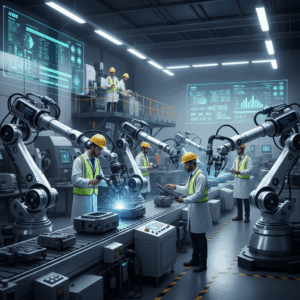Impact of AI-Powered Automation on Business Operations
AI-powered automation is transforming business operations by significantly boosting efficiency and accuracy. This shift allows companies to streamline workflows and reduce errors, accelerating overall performance.
By automating routine tasks, businesses free employees to focus on strategic activities. This change drives innovation and enhances decision-making, helping companies stay competitive in fast-evolving markets.
Additionally, AI enables real-time data processing and predictive insights, further optimizing operations and reducing costs. The result is a more agile, cost-effective business model that responds well to customer needs.
Enhancing Efficiency and Accuracy
AI automation takes over repetitive, time-consuming tasks like data entry and compliance checks. This reduces human errors and speeds up processing times, increasing overall operational efficiency.
Streamlined automated workflows allow companies to handle larger workloads without sacrificing quality, supporting scalable growth. AI-driven processes ensure tasks are performed with consistent accuracy at every step.
Furthermore, these efficiencies free human resources for creative and high-impact endeavors, fostering innovation and improving employee satisfaction by minimizing mundane work.
Improving Decision-Making and Reducing Costs
With AI analyzing vast amounts of data in real time, businesses gain access to smarter, faster decision-making tools. Predictive insights such as demand forecasting help reduce operational risks and expenses.
AI-powered automation minimizes downtime by monitoring equipment and processes proactively, thus reducing maintenance costs. The ability to anticipate problems before they escalate improves cost efficiency significantly.
This enhanced decision-making capability supports more informed strategies and resource allocation, enabling companies to cut costs while maintaining agility and responsiveness in dynamic markets.
Key Applications of AI Automation in Companies
AI automation is reshaping how companies operate by focusing on core activities that enhance productivity and innovation. From handling repetitive tasks to enabling smarter decisions, AI applications are diverse and impactful.
By adopting AI-driven solutions, businesses streamline operations, improve customer interactions, and leverage real-time data to predict trends. These applications foster growth and adapt to evolving market demands efficiently.
Automating Repetitive Tasks
AI-powered automation efficiently handles repetitive tasks such as data entry, invoicing, and compliance checks. This reduces manual errors while accelerating task completion.
Automating routine work frees employees to concentrate on strategic projects, driving innovation and boosting overall workplace satisfaction. Accuracy and speed improve simultaneously.
This automation also scales easily, allowing companies to manage higher volumes without increasing labor costs, which enhances operational agility and cost-effectiveness.
Real-Time Data Analysis and Predictive Insights
AI systems analyze vast amounts of data instantly, delivering insights that help businesses optimize decisions and forecast demand with greater accuracy.
Predictive analytics reduce unexpected downtime by identifying maintenance needs early, thereby saving costs and improving operational continuity.
These real-time insights empower companies to react swiftly to market changes, making their strategies more proactive and data-driven.
Transforming Customer Engagement
AI-powered tools like chatbots and personalized recommendation engines revolutionize customer interactions by offering timely, relevant support and suggestions.
This personalization enhances customer satisfaction, loyalty, and retention, making experiences more engaging and tailored to individual preferences.
Automation of customer engagement processes also reduces response time and operational costs while expanding service availability around the clock.
Scaling Operations and Continuous Learning
AI automation allows businesses to scale operations efficiently, managing increased workloads without proportional rises in costs or resource demands.
Additionally, AI systems continuously learn from new data, adapting their performance and improving accuracy over time across various industries.
Continuous Improvement Through Machine Learning
The adaptive nature of AI ensures that automation evolves with business needs, enhancing flexibility and resilience. This continuous learning drives sustained competitive advantage.
Steps for Implementing AI-Powered Automation
Implementing AI-powered automation requires a strategic approach focused on identifying key processes and planning their automation carefully. This ensures alignment with business goals and maximizes ROI.
Companies must invest in workforce training and monitor performance continuously to optimize automation benefits. Proper implementation fosters smooth integration and sustainable success in AI projects.
Identifying and Planning Automation Processes
The first step is to analyze business operations and pinpoint repetitive, high-volume tasks suitable for automation. Prioritizing these processes leads to quicker returns and smoother adoption.
Clear goal setting and selecting the right AI tools tailored to specific needs are essential for effective planning. Phased rollouts help manage risks and allow incremental learning during implementation.
Engaging stakeholders across departments improves process understanding and ensures that automation efforts address real pain points, thus enhancing acceptance and effectiveness.
Workforce Training and Performance Monitoring
Successful AI automation depends on educating employees about new technologies and workflows. Training programs should focus on skills that complement AI, such as problem-solving and decision-making.
Continuous monitoring of automation systems and workforce performance helps identify bottlenecks and areas for improvement. This feedback loop drives ongoing optimization and system accuracy.
Balancing human oversight with automated tasks ensures quality control and mitigates risks, enabling companies to maintain operational resilience while maximizing productivity.
Benefits and Strategic Advantages of AI Automation
AI-powered automation delivers significant productivity gains by streamlining processes and reducing manual effort. This leads to faster task completion and higher output without additional workforce.
Companies also benefit from substantial cost savings through minimized errors, reduced maintenance, and optimized resource allocation. These savings improve overall financial health and sustainability.
The strategic advantages gained position organizations to innovate and adapt rapidly, enhancing long-term success and market responsiveness in competitive landscapes.
Productivity Gains and Cost Savings
Automation of routine tasks enables employees to focus on higher-value projects, increasing overall productivity. This shift enhances business agility and operational efficiency simultaneously.
Cost reductions arise from fewer mistakes, less downtime, and decreased manual labor requirements. These factors combine to lower operational expenses significantly.
Additionally, AI-driven insights allow better forecasting and resource management, preventing overproduction or shortages, which contributes to efficient budgeting and cost control.
Competitive Edge and Innovation Enablement
Implementing AI automation offers a clear competitive edge by accelerating innovation cycles and improving customer experiences. Businesses gain agility in responding to market changes.
With AI continuously adapting and learning, companies can introduce new products or services faster, staying ahead of competitors and meeting evolving consumer demands effectively.
This technology fosters a culture of innovation by freeing human talent to experiment with creative solutions, driving sustained growth and leadership in their industries.







